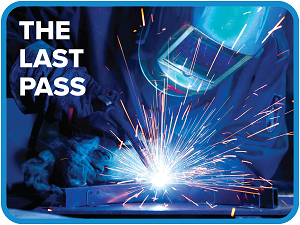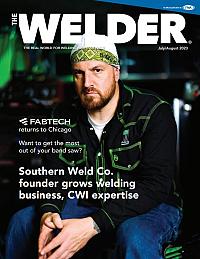Program Coordinator/Welding Instructor
- FMA
- The Fabricator
- FABTECH
- Canadian Metalworking
Categories
- Additive Manufacturing
- Aluminum Welding
- Arc Welding
- Assembly and Joining
- Automation and Robotics
- Bending and Forming
- Consumables
- Cutting and Weld Prep
- Electric Vehicles
- En Español
- Finishing
- Hydroforming
- Laser Cutting
- Laser Welding
- Machining
- Manufacturing Software
- Materials Handling
- Metals/Materials
- Oxyfuel Cutting
- Plasma Cutting
- Power Tools
- Punching and Other Holemaking
- Roll Forming
- Safety
- Sawing
- Shearing
- Shop Management
- Testing and Measuring
- Tube and Pipe Fabrication
- Tube and Pipe Production
- Waterjet Cutting
Industry Directory
Webcasts
Podcasts
FAB 40
Advertise
Subscribe
Account Login
Search
The Last Pass: How welders can build their professional network
Why it's important for young welding professional to expand their relationships in the industry
- By Greg Siepert
- Updated August 15, 2023
- August 15, 2023
- Article
- Arc Welding

For young welders looking to grow their welding career, it's helpful to expand a professional network.
Last time, I introduced the best advice I have received as part of a three-part series I have in mind.
Those three things I was told early in my career are:
- Find the professional organization associated with your career field, join it, get involved, and read any magazines or journals it publishes.
- Actively build your network.
- Never stop learning in life (this includes finding and maintaining a hobby to keep your curiosity alive).
That second item was one of my biggest struggles, as I did not understand what it meant when I was told to "build my network." Initially, I did not see the correlation between the three items and approached them like a to-do list.
It is often stated that it’s all about who you know, but what does that even mean at the end of the day? Building the network is a multifaceted, two-way street.
Where I struggled was learning the conversational part of it, the relationships part of it. I would be introduced to someone, shake a hand, and then go on my merry way, checking another box on the growing network list.
It was not until later in my career that I realized there are no specifics to it. Some individuals have extensive networks, while others have smaller networks. The most crucial part is the relationships within that network, not just the introductions and handshakes.
As I became more involved with the Kansas section of the AWS, I had a lightbulb moment as I realized that joining a professional organization and building my network went hand in hand. That first piece of advice played into the second.
Through the interactions, I met future mentors and lifelong friends, learned from others, and made industry connections. As I attended more events locally and nationally, I also began to have conversations about educational practices with education and industry leaders; I gained further insight on the welding industry and trends; I interacted with like-minded people from all walks of the industry; and I was challenged with new information, technology, and learned more about the field I was in.
As my career progressed, my network grew in the welding and fabrication industries, as well as in education and business. I learned the importance of trading contact information, reaching out, and providing value when possible. Contact information may be in the form of a business card, a digital connection, or social media. Whatever form you choose, make sure to have a confident introduction—a handshake if appropriate—and talk to the individual actively. Do not be intimidated by their title or experience; embrace it, as you never know what you have to offer.
While it may seem intimidating initially, reach out to professional organizations. Find a meeting or event and begin building your network. You never know who you might meet and how that might impact your future in finding answers, providing professional training opportunities, or leveraging a career move.
Once again, I want to thank those who have reached out. If you have time and want to share more, email me your questions, comments, and ideas at thelastpass.thewelder@gmail.com.
About the Author

Greg Siepert
Hutchinson Community College
1300 N Plum
Hutchinson, KS 67501
About the Publication
subscribe now

The Welder, formerly known as Practical Welding Today, is a showcase of the real people who make the products we use and work with every day. This magazine has served the welding community in North America well for more than 20 years.
start your free subscription- Stay connected from anywhere

Easily access valuable industry resources now with full access to the digital edition of The Fabricator.

Easily access valuable industry resources now with full access to the digital edition of The Welder.

Easily access valuable industry resources now with full access to the digital edition of The Tube and Pipe Journal.
- Podcasting
- Podcast:
- The Fabricator Podcast
- Published:
- 04/16/2024
- Running Time:
- 63:29
In this episode of The Fabricator Podcast, Caleb Chamberlain, co-founder and CEO of OSH Cut, discusses his company’s...
- Trending Articles
Sheffield Forgemasters makes global leap in welding technology

ESAB unveils Texas facility renovation

Engine-driven welding machines include integrated air compressors

How welders can stay safe during grinding

The impact of sine and square waves in aluminum AC welding, Part I

- Industry Events
16th Annual Safety Conference
- April 30 - May 1, 2024
- Elgin,
Pipe and Tube Conference
- May 21 - 22, 2024
- Omaha, NE
World-Class Roll Forming Workshop
- June 5 - 6, 2024
- Louisville, KY
Advanced Laser Application Workshop
- June 25 - 27, 2024
- Novi, MI



























